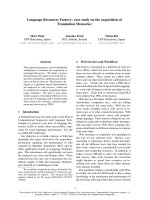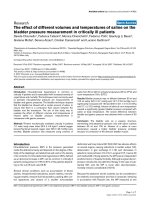Architectural inculturation and transformation case study on the three catholic churches in java
Bạn đang xem bản rút gọn của tài liệu. Xem và tải ngay bản đầy đủ của tài liệu tại đây (5.72 MB, 37 trang )
APPENDIX 1
ARTICLES
St. Claverbond Magazine, 1929
109
110
111
112
113
St. Claverbond Magazine, 1929:
Is Catholic Church-Building in Javanese Style?
By H. Caminada, S.J.
(19 Follow-up, p. 316; fortieth vol).
Of all their building forms on Central Java, Djoglo-type seems the most capable of
conferring for a R.K. church. It is a form in which the building is the most developed. In the
past, Djoglo is only for Javanese nobility reservations and is still the stamp of family name’s
load bearing and dignity. Above is in the base square, and therefore more suitable than the
kampoeng (limasan) type; that has a right angle to the fore, with long side to its base. It would
be then djoglo-form as the head-form of a church building, but raises two options: one can
question the priest-chorus places on the edge of this djoglo whether the application of the
central building of our Catholic churches is by the altar (whole in the middle), therefore the
four sakagoeroe's tusschen (head pillars) get its award. This last raises many practical
objections with regard to the first way, so that would be far preferable. The priest-chorus
would have been as in a separate building hereby able to join in djoglo-form and special in
“witana” form.
There is still the choice “tusschen” as an open or a closed construction. The first,
which the goals we have already been said, is not possible, unless the location (“farm”) has a
wall in surrounded: the gate “tusschen” in the wall and it is in fact would be a screen of the
building (“banon kelir”) to make, so as in the some houses, in the Djocjakarta Palace several
times can be found. But then fencing and form of a whole church building and the parish can
achieve that, without the “farm” of the Church to enter.
From the others side is for the safety; more a closed methods of accustom
construction and this seems also comfortable to the most people. In the house of Javanese
prijaji's (nobility) custom, we can see a “farm” still conclude with a wall, through a gallery, in
this case it would be able to process “status” fitting.
114
In order to clarify what happens to our today’s economic challenge, Javanese building
(if they can achieve it), and also by way of taster on p. 20, 21 and 22 displayed a draft of a
R.K. Church in Central Javanese style. The church and priest-chorus both are raised in a
closed djoglo-form: the first to point `bovendak, the second to finish the four upper surfaces in
a short balk. The rafters lie with both djoglo's light-sources. The priest chorus builds as the
sacristy, as in “emper” (in order to bring choir in the manner as in the usual western churches,
but here the roof is low; so make it impossible to be similar with western churches). However,
in both tower such a far taller affixing meters (making it into account that the Javanese sit in
the long land). The height would be able to use for the choir voice, left as the doop-kapel
(chapel specific for baptism). I refer here still on a typical Javanese construction, which is can
make also in the above harmony. As to mention by the church door, they must first be on a
stepping-stone before the “mats” (carpet) can take place. This height floor arises in the most
houses of well-off Javanese, not all in the pendopo, but also in the house behind, generally
low-floor also runs by along the sides. However, in order to save more space, it is in the draft
has been omitted.
It would perhaps bring an opposed to the Javanese church construction above, the
great of the poles that apparently want to support the roof. The poles, except the four saka
goeroe's, however, are relatively thin; nobody will have the courage to be aware. It is
especially in a Javanese pendopo has burden to make such magnitude figure pillars.
Nevertheless, it would, if they wanted, this objection for large part by the modern technology
under capture may be, without its being Djoglo-form thereby prejudicing, provided that at
least two rows pillars let alone.
A different problem, which could eventually make that ultimately, is the form of the
church. It is not much different from mosque building; and on a “mosque similar” church our
Catholic Javanese would never be satisfied. I must admit, that means in the first glance,
people might think of a mosque. The pointed point and the opening “tusschen” of the two
upper roofs are indeed to each mosque own. Indeed, the roof is also point to the ordinary
pendopo-form, and the light-and the scene will take place there was often in closed dwelling
115
construction-compare e.g. the women stay of the Crown Prince of Djocja and the bangsal
kantjana (open throne-room) in the Palace. In addition to the draft, the missing “serambi”,
something fundamental to the mosque type, and act for two small towers in the place, what is
never be found at a mosque. Before we can finish leaves to answer a question: will the
Javanese church construction nicer than the church that followed the Catholic construction
characteristics? We cannot deny that many Javanese, under the incidence of European culture,
in their house construction (a predilection for the construction) showed characteristics of the
western. This will mainly take place here; because the Javanese architecture has not yet been
able to adjust to the modern (especially of the hygiene and social development).
In addition, it is more simply to adopt the western style church building or objects. So
then many unintentionally people, they build such a specific characteristic methods of
construction of a Catholic Church. In the long term, once at beginning, they will have made
with Javanese church construction, and it is to be expected, that most Javanese more taste in
their own methods of construction, as they will find in the exotic forms. For them, which are
practiced architectural and familiar to, not only with the Javanese artistic expression, but also
with the art history of Catholic Church and especially for a Catholic “house of prayer”; is an
open extensive field to develop their artistic ideas. Especially for the Javanese artist, which
are better than Westerners, their feelings to savor his country can interpret them, is a great
area for deployment of the truly Javanese construction and sculpture and this would be a
wonderful opportunity to contribute to deepening the religious of Javanese people.
116
St. Claverbond Magazine, 1929
117
118
119
120
121
St. Claverbond Magazine, 1929:
A Draft to the Village Church of Ngidjon
By H. Caminada S.J.
Some time ago I was a missionary who was given a job to design a village
church in Ngidjon. The church should be able to accommodate about a thousand
believers, and in addition it should not be too expensive.
It may sometimes be useful to focus on this last factor, because this is a
demand with which we build our church for Javanese will constantly take into
account. This demand comes not only from the financial conditions, which was found
in every mission area, but also from the fact that we are in church architecture to
adapt to the social condition of the Javanese people. This applies a fortiori to a village
church, because it still will take very long before the welfare of the villagers have a
significantly higher level will be achieved.
A village church should be simple, suitable with the simple, often the poor of
the village houses. It should be better if the model were taken from the house of a
village chief, but for a church, it should not be more than the Catholics villagers
expectation. For now, without financial support from the West, they will not be able
to build their own churches.
To meet the above demands, we saw it – see picture at page 200 – two turrets
at the front, but on either side of the main entrance, leaving enough space to later be
able to place. As a model for the ship, we chose the less precious limasan form, and
well as appearing in the Kraton, with an opening between the top – and bottom- roof.
The sanctuary was in joglo form (witana form), but with a groove between the roofs.
A new construction is the connection – roof between the two housing types, but that
also can be omitted. Then the sanctuary is close each to other.
We can simultaneously overcome a problem that probably has been risen by
any other reader, why two models of houses are made all in one. This question is
easily answered, as I previously imparted, there is a Javanese house, we take as an
example of a wealthy Javanese, it contains a pendopo building in joglo form, a
pringgitan building in limasan form, and back home in limasan or joglo form. Thus,
there are three separated roofs. Yet no Javanese saying, “How strange this man builds
three houses in a row”, but such construction is very common and also considers the
122
whole house. The same case can be found in a mosque, which consists of two
different roof structures. Moreover, it would be a contrast if we construct a large
building that is bigger than surrounding houses, and the performance that would be
more equal in material demands - iron contruction! – will increase the costs too high.
In contrast to the ordinary Javanese houses roof, the roofs of this church are
higher. The slope of the lower roof of the Javanese house is about 15°; however, for
this church, it is more than 30°. This is done only for practical reasons. Indeed, in a
larger angle, there is not much danger during heavy tropical rains, but it can be an
expensive wood paneling on the inside of the roof.
What material is needed by such a church building? The skeleton is, like all
Javanese buildings made from wood, by its ingenious design easily resist against
earthquake, not overwhelming. The 6 main pillars of A, B, C, D, E, F, see drawing
p.202 – and 4 saka guru’s – G, H, I, K – from the sanctuary support a large part of the
building. Ideally, these pillars are made of teak wood.
The closure consists of half brick wall, or, better still, from whipped potassium
stones, excellent resistance to burglary attempts. The roofing employed tiles or may
be, if one prefers, sirap (boards of ironwood).
For the finishing of exterior and interior, it can easily take into account the
financial capacity of the parishioners, and with cash contributions, for the decoration
of the connecting beams the main pillars of Javanese carving to decorate, as this is
found into the homes of wealthy Javanese, and then with gold and red and green paint
to make them polychrome.
Whether this adaptation challenges the desired direction for our Catholic
Javanese, the need to teach our Javanese parishioners is a must. Especially this will
depend on the development of the Javanese house architecture, either in the long term
will adapt to the western design, either, despite Western influences in its original form
will be able to maintain.
With the housing in the village one will be an adaptation to preliminary
models do not need to fear.
123
St. Claverbond Magazine, 1935
124
125
126
127
128
129
130
St. Claverbond Magazine, 1935
The H. Heart-Church at Poegeran
By ADR. Soesanta
Several months ago, it was notified in the Indische sheets, that the mission to
Djocjakarta was last, after 15 years of tireless work, effecting under the leadership of the
famous priest H.E.F. van Driessche S.J., a pretty church building was able to give to God, in
the district of Bintaran. That church building, which is indeed a dignified residence was
offered to Christ in the eucharis, see vol. 1934 P, 114 and following.
What really gratitude were at a time when all hearts full of joy. And now, after about
four months, we again witness the inauguration of another new church; we also see a building
and construction, designed by a talented architect, Th. van Oyen in a Javanese
environmentally appropriate style.
While the construction of church undertaking of Holand Betonmaat quickly
progressed, they drew the attention and got interest of the European society as of the
indigenous of Catholics. Every day there were hundreds of Javanese come to see how far the
construction had been advanced. After the long waited, the day of the inauguration finally
broke up. On Sunday 8 July, the Church is solemnly to be worn to God. On this day, the
Church, built of very strong materials that have been in a building, that on all sides carried
light and power, and that all relentlessly approaching to the God's altar, attracted so many
people. Hundreds of the Catholic people from far of the areas of the Djocjakarta region, at
Saturday night, came to the city, then at the following morning they helped in the ceremony.
No wonder therefore, that the wide parties were around the church and the parish, as well as
the streets in the district Poegeran, whether in the outside area, also present thousands of
interested parties, including many curious Muslims and people with other religions. When the
clock venerable stroke seven hours, pater Dr A. van Kalken S.J. appeared, in order to carry
out the opening remarks.
The deepen impression made by the devote attitude of misdienars, which preceded
131
the priests in the area of church. The inauguration of the Church had taken place from the
outside, followed by many prayers of the Javanese Catholic Church, in which the blessing of
God with the prayer. While the ceremony was still in the process, the church doors were
opened. And the parade of priests and misdienaars entranced to the church building, with
formal and quiet, and which respect to the names placed in the table or on the carpet. All the
mass then also entrance to the new building, carefully followed what the priests did. At the
time, the Church was filled until the final and yet there were still hundreds of the people in the
square, with no opportunity to capture a space within the church.
For the altar the litany of All Saints Day was prayed, deployed by the Javanese choir
under the leadership of Mr J. Prawira Soemarta.
It is now once again God so clearly showed His richly creating on Djocjakarta. There
were indeed over Catholic Javanese, which by their very lively testimony of resignation and
their deep belief in God. After the submission by priest (and help of the assistance), the within
Church were devoted; and then followed by the solemn high mass, including a short
encouraging speech took by Father A. Soekiman, S.J.
Under the Sacrament of Eucharist, for the first time in this new church building,
hundreds and hundreds of people came forward to pick the Heart. In the area of Church there
was a statue as a contract to the divine heart of Jesus, see Figure P. 51. How is Jesus, in his
divine heart has felt thousands His “sheep” collected for his effigy!
They knew how to encourage the Javanese, when they speak with one voice, which
allowed to the divine Heart that also was punctured for faith, all caused by love. After the
solemn commitment to Jesus (Sacrament Eucharist), it seemed full out of the His chest,
radiated on the church "To you, o King of the centuries".
After the last voice of the organ, in the Church was finally returned to the Javanese
traditional music, in which the Javanese passionately expressed their love to God.
Yes truly thank God for blessing all hearts. Thank God and love towards God; thank
also the missionaries Jesuit, for all their effort in order to bring the knowledge of Jesus Christ
to us, the Javanese!
132
For the reception, which is followed after the mass, was also very interesting for both
the Javanese as well as the representative of European Catholics.
The first word took by the venerable father, Dr. A. van Kalken S.J., which speak in
Javanese language to the Javanese Catholics and then in the Dutch language to them; so then
Javanese language was about a half. His venerable mention was that the new Church had been
increased during 75 years labor of the missionaries Jesuit in the Netherlands Eastern Indie. It
is clearly as blessing. 400 years ago occupation was started in this country but during 50 years
(1808 - 1859, was the seed, sown by the missionaries, smothered and further missionary had
been made.
Jesuit arrived in Netherlands Indie at first on 9 July of the year 1859, so 75 years ago,
was driven through systematic and intensive, it was also among many hardship and sacrifices.
The venerable missionaries, the Jesuit, so they persecuted as Father Superior, and
they were on 9 July, at the day of commemoration of their 75 year olds labor in Netherland
Indie, present respectfully to God, nothing better than this church building.
133









